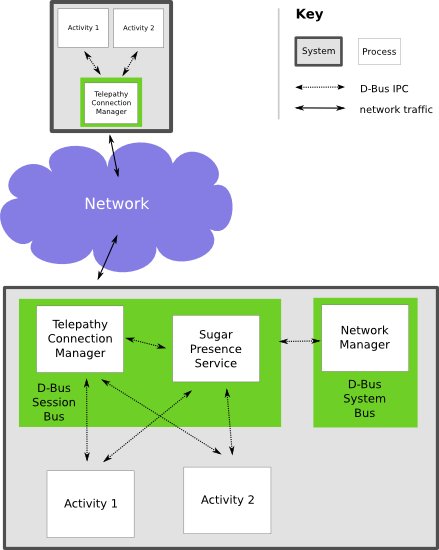Activity sharing
Overview
Collaboration in Sugar activities works using a set of services that run on the laptop, and APIs in the Sugar Python modules that wrap those services. The main services are the Telepathy connection managers and the Presence Service that coordinates them.
Telepathy is a system describing a generic interface for various kinds of communication. It is the underlying infrastructure used by Sugar for collaboration. Currently, two Telepathy implementations are used: Gabble, for Jabber, and Salut for serverless Jabber (a.k.a. link-local XMPP). The former is used when the school server is reachable; the latter in the simple mesh case.
Advertisements and invitations
Shared sugar activities are discovered in two different ways: through broadcast advertisements, and through invitations.
Advertisements are made when the user tells the activity to share itself with the entire network. Anybody on the network can see the activity.
Invitations are send to particular users. Only those users who are sent an invitation see the activity (unless the activity has also been advertised). When Sugar recevies an invitation, it asks the user whether they want to accept or reject it.
Tubes
Tubes are a means for shared activities to exchange data. There are currently two types of tubes:
- D-Bus Tubes provide a D-Bus bus service that is shared between the participants in a shared activity, providing signals to all participants, and methods called on a particular participant.
- Stream Tubes provide a socket-like connection set up via XMPP, for data streaming like HTTP, between two participants.
Using tubes in Sugar activities
The Presence Service creates connection manager objects (Gabble and/or Salut). It gets a Connection object (to the Jabber server in the case of Gabble). PS creates or gets a Tubes channel. For Python Activities, Sugar creates or joins a D-Bus tube automatically.
The initiator of the activity should then call Tubes.OfferDBusTube to offer a Tube with a specific service name. When a buddy joins an activity, he will try to figure out which Tubes are available by calling Tubes.ListTubes() on the tubes channel (which he doesn't have to create anymore). Both OfferDBusTube and ListTubes result in a callback when the Tube becomes really available. Only then a working Tube is handed to the (shared) activity and it is possible to export objects on that bus and subscribe to signals etc.
See Collaboration Tutorial for more on using Tubes.
Who's who?
Buddies/nodes within an activity are currently identified with different handles by different components. The following handles can be distinguished:
- Dbus name. If you have a Dbus related function with the “sender” argument specified, this is what you'll get. To buddy object:
sugar.presence.PresenceService.get_buddy(buddy's public key)
- Telepathy handle. To buddy object:
sugar.presence.PresenceService.get_buddy_by_telepathy_handle(tp_conn, tp_conn_path, handle)
Interactions
How the various components interact.
Presence Service ⟷ connection manager
- org.freedesktop.Telepathy.ConnectionManager
- RequestConnection
- org.freedesktop.Telepathy.Connection
- RequestChannel
- org.laptop.Telepathy.BuddyInfo
- org.laptop.Telepathy.ActivityProperties
activity ⟷ Presence Service
- org.laptop.Sugar.Presence
- org.laptop.Sugar.Presence.Buddy
- org.laptop.Sugar.Presence.Activity
activity ⟷ connection manager
- org.freedesktop.Telepathy.Channel.Type.Tube
- OfferDBusTube
- OfferStreamTube
